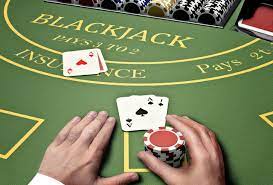The card game of blackjack is one of the most popular casino table games in the world. It’s a simple game to learn, for players and most importantly, for the casinos.
By learning and playing the game of blackjack, most beginners can quickly improve their hand-to-hand combativeness and use a structured betting system. But, the beauty of the game is that most of the skills one would learn in other card games are transferable to the game of blackjack.
In blackjack, players are dealt two cards – theirs and the dealer’s. The goal of the game is to get as close to 21 as possible without going over. The two cards the player is dealt are sometimes referred to as the player’s cards, and the face down card the dealer is dealt is called the dealer’s card.
When a game of blackjack begins, a dealer starts at one of the positions at the table and a small disc (dealer) spins round a little wheel with the words “Dealer” on it. When the deck is first shuffled, the two cards that the player is playing with are placed face down on the table – hence the term “used cards.”
Since the objective of blackjack is to get as close to 21 as possible, there’s no benefit in referring to cards as though they were playing cards. Instead, a player should think of his or her two cards as they are, unaware of what the other player’s cards may be.
When betting, a player only needs to put up an amount equal to the table minimum – this is called a betting “place.” The bets then get bigger every time a player doesn’t bet something, called a blind.
However, there’s more to a good game of blackjack than just the right place to put your bet. If, for example, you have £50 on the table you could say “50, please.” This could possibly be read as “the boxcars” or “Naga303.” However, if you want to be intimidating, you can say “£100 please.” This may seem quite haphazard, but in blackjack terms it means you are heavily padded.
When you are in a table of more than one player, you can make a simple mathematical calculation to see if you are in a good position. If your calculation is correct, you’ll have a good advantage over the house; if you are wrong, you’ll probably be holding a bad hand.
The player with a 12 or higher, or who has a pair of aces, will probably be the first one to go, because casinos take a glance at all of the cards on the table before shuffling. With a 12, there is a chance that the dealer could have a low card, which would make a 16 less likely. The opposite with a pair of aces, because casinos are likely to have a high card – but if the dealer has a 6 or lower, there is still a possibility that the hole card he is holding is better than your aces.
However, the most powerful card in your own hand could also be the one you give to the dealer. This is the card that could make your hand a very valuable one, so you will need to consider, as it is also the card most likely to make the dealer’s hand better as well.
There are some combinations that may not work as well, such as two sixes, or two threes. You can also watch for the cards that, if they hit, are likely to bust the dealer, so you could for example wait to make a hand until such a time arrives that the dealer’s up card is a 10.
Be sure with all of these combinations, as they are not always the way to go. Some blackjack combinations may also work in favor of the player, so another strategy is to keep track of the cards as they lay face up.
